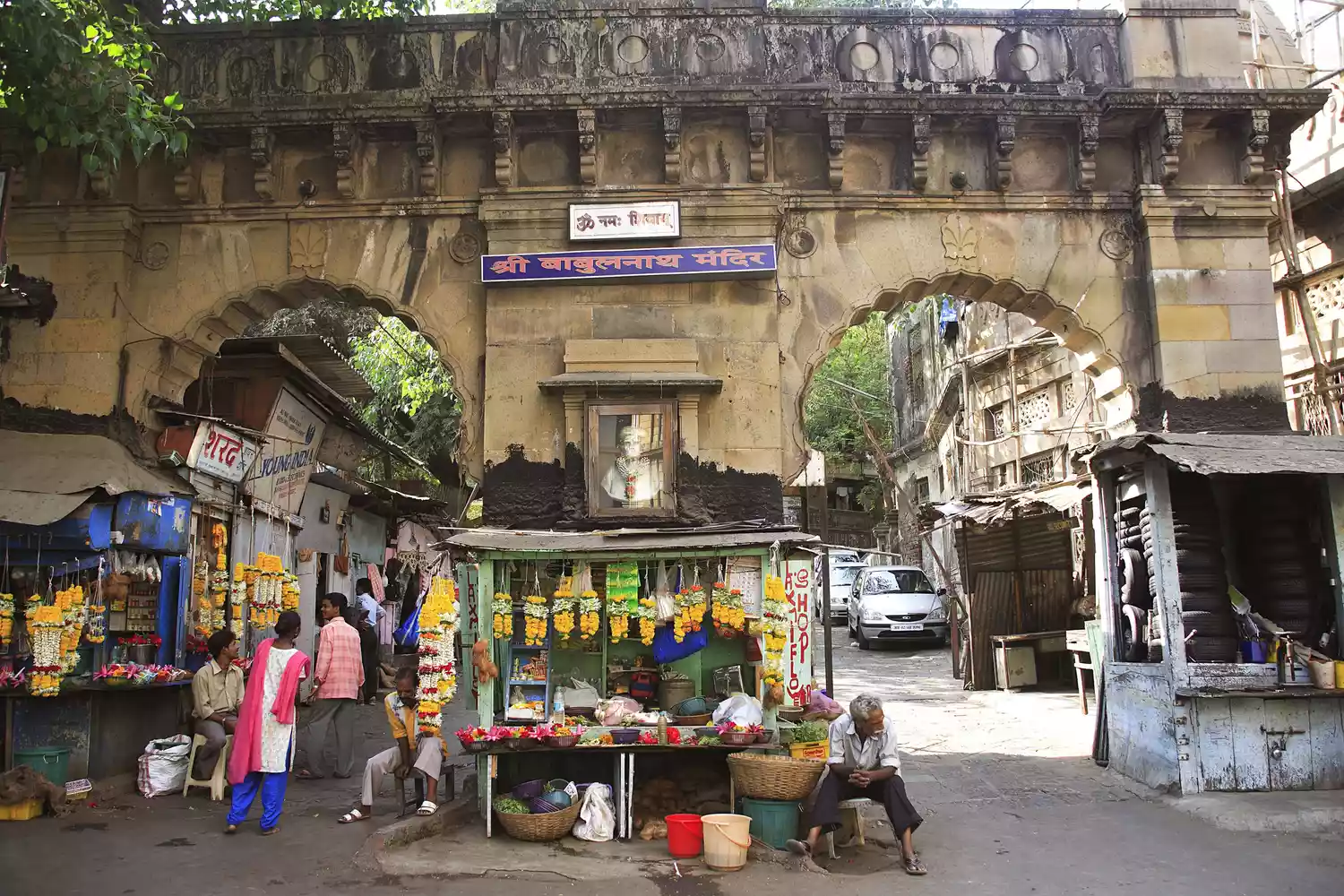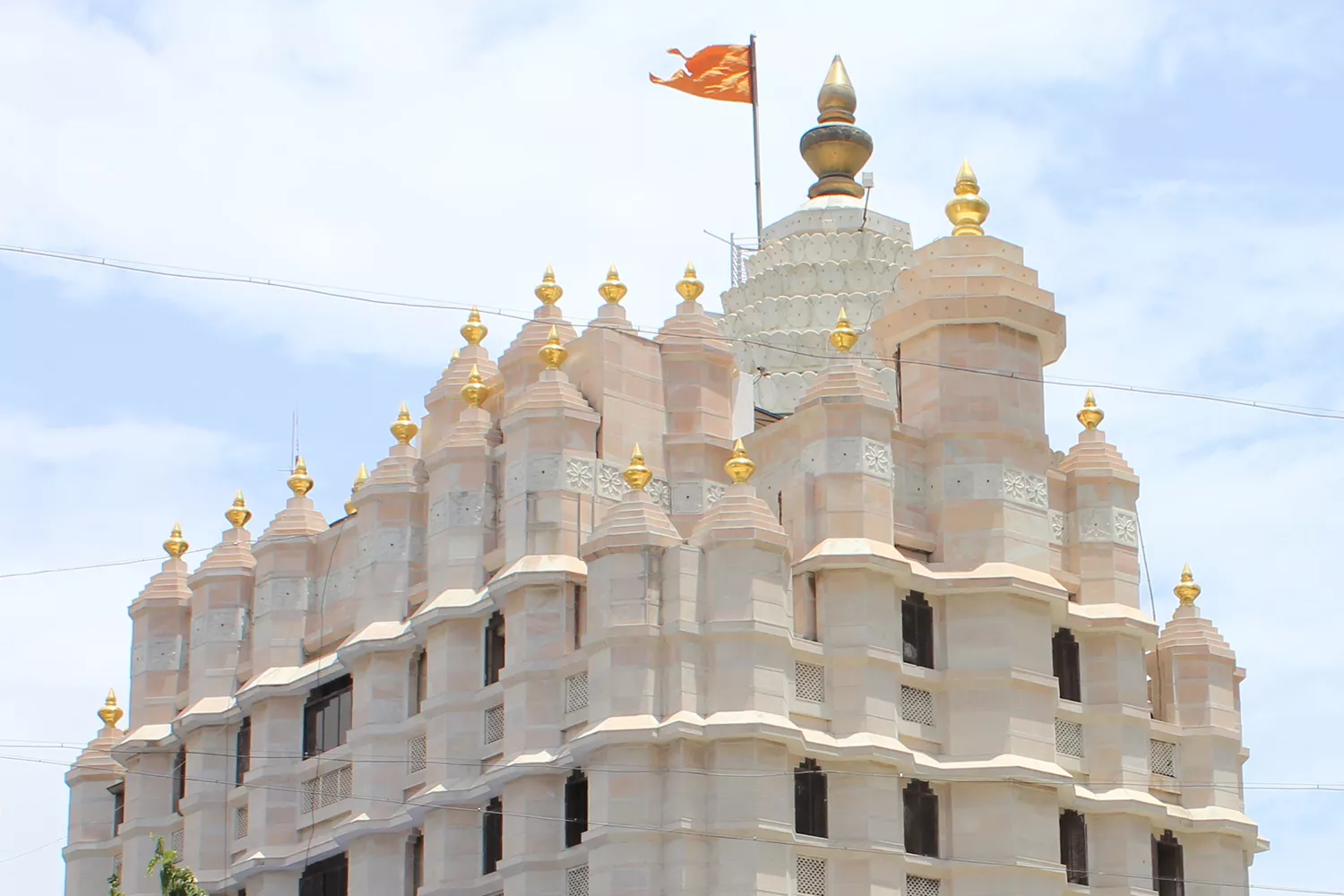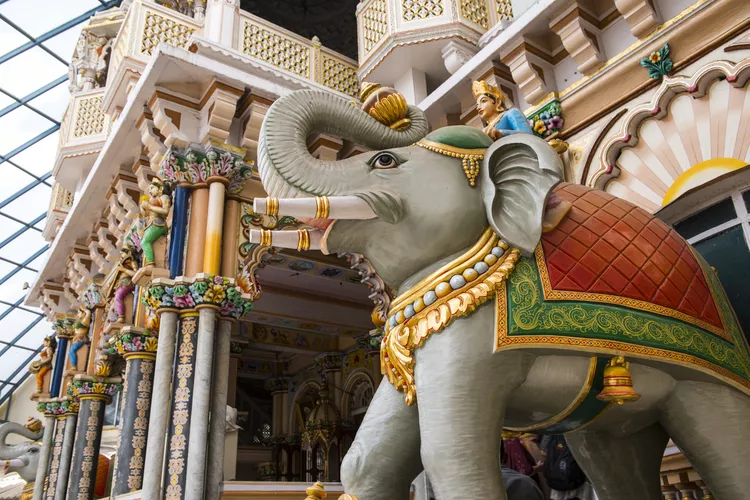Summary
From Judaism to Hinduism, all religions are represented in Mumbai. Visit these 15 landmark Mumbai temples and other religious places of worship to gain insight into them. For a more in-depth understanding, consider taking the insightful People of Mumbai tour or Jewish heritage tour offered by Mumbai Magic.
Mumbadevi Temple

The Mumbadevi Temple is dedicated to the goddess Mumba, whom the city of Mumbai was named after. This otherwise unremarkable temple is noteworthy because the Koli fishermen, believed to be the original inhabitants of Mumbai, worshiped the goddess and built a temple for her. It was demolished in 1737, and the current Mumbadevi Temple subsequently replaced it.
Going inside the temple is an adventure in itself. Be prepared to navigate through a sea of people, as the temple is situated in a crowded market area. However, this experience truly connects visitors with the city’s heart and history. Numerous pandits reside behind the temple and perform puja rituals for those who desire them.
- Where: Mumbadevi Marg, Bhuleshwar. (To the north and right of Zaveri Bazaar).
Keneseth Eliyahoo Synagogue

Keneseth Eliyahoo Synagogue, built in 1884 by Jacob Elias Sassoon and his brother Albert, is a soothing light blue colored building adorned with pillars, chandeliers, and stained-glass windows. View it best in the afternoon when it’s beautifully illuminated by sunlight. If you want to take photos inside, be prepared to pay 100 rupees.
The synagogue reopened in early 2019 after a magnificent restoration that took nearly two years. As part of the works, the building’s distinctive blue-painted exterior was scraped away to reveal its original stone and color. Consequently, visitors might notice police presence outside the synagogue, as every synagogue in Mumbai now has 24-hour police security after the 2008 Mumbai terrorist attack.
- Where: V B Gandhi Road, Kala Ghoda district (just around the corner from Rhythm House), Fort, Mumbai.
Holy Name Cathedral

The opulent Catholic Holy Name Cathedral was built to replace the older one in nearby Bhuleshwar and is decorated with an array of artwork. Opening its doors for worship in 1905, it’s renowned for its delicate frescoes and pipe organ, which was a gift from various Popes, including a huge bell from Pope Paul VI, who visited in 1964.
- Where: 19 Nathalal Parekh Marg/Wodehouse Road (opposite the YMCA), Colaba, south Mumbai.
Afghan Church

The Presbyterian Afghan Church, officially known as The Church of St John the Evangelist, was built by the British to honor the thousands of soldiers who lost their lives during the First Afghan War (1835-43). It showcases quintessential English design and is classified as a Grade I heritage building. Considerable funds have been allocated to restore its stained glass windows.
- Where: Navy Nagar, Colaba, south Mumbai.
St. Thomas’s Cathedral

St. Thomas’s Cathedral provides a peaceful respite in a bustling part of the city and is renowned for its award-winning stained glass work. As the first Anglican church in Mumbai, it dates back to 1718, initially constructed to establish a moral foundation for the growing British settlement. It became a cathedral in 1837, with the tower and clock added a year later.
Interestingly, Mumbai’s Churchgate district derives its name from the gate in the Fort built by the British East India Company, which served as an entrance to the church. The area west of the church continues to be known as Churchgate today.
- Where: Veer Nariman Road, close to Horniman Circle Gardens and the Flora Fountain.
Babulnath Temple

The Babulnath Temple is an ancient site dedicated to Lord Shiva, symbolized by the Babul tree (a type of acacia native to India). Built in 1780 following the discovery of buried idols, the temple sits 1,000 feet above sea level. Therefore, should you prefer not to climb the numerous stairs, you can opt for a lift for a small fee.
This temple sees considerable activity on Mondays, an auspicious day for Lord Shiva, with many devotees gathering to celebrate the Shivratri festival.
- Where: Babulnath Road, Malabar Hill, near Marine Drive, south Mumbai. Opposite the Bombay International School.
Babu Amichand Panalal Adishwarji Jain Temple

Jain temples are known for their elaborate architecture, and the Babu Amichand Panalal Adishwarji temple is no exception. Built in 1904, it is adorned with colorful ornate sculptures and paintings. The entrance showcases two stone elephants on either side, while the dome ceiling is resplendent with zodiac signs.
This temple is dedicated to Lord Adishwar (also known as Rushabhdev), the first of the 24 Jain “Tirthankaras” (liberated souls who guide others away from the cycles of death and rebirth).
- Where: Ridge Road, Walkeshwar, Malabar Hill, south Mumbai.
Walkeshwar Temple

The Shri Walkeshwar Temple was established by the Gowd Saraswat Brahmin community in 1127. Legend has it that Lord Rama paused at this location when heading to Sri Lanka to rescue his wife Sita from the demon Ravana. Unfortunately, the Portuguese destroyed the temple during their reign in the 16th century. Nevertheless, it was later rebuilt by another Gowd Saraswat Brahmin in 1715.
The ancient Banganga Tank is part of the temple complex.
- Where: Malabar Hill, south Mumbai.
Haji Ali

One of the top attractions in Mumbai, the imposing Haji Ali serves as both a mosque and tomb. Built in 1431 by the wealthy Muslim merchant and Sufi saint Pir Haji Ali Shah Bukhari, it also contains his body. Situated in the middle of the ocean, Haji Ali is only accessible during low tide via a narrow, 500-yard long walkway. On Thursdays and Fridays, tens of thousands of pilgrims flock there to receive blessings from the saint. Should you need to pass some time until the tide lowers enough, there is a shopping center across the road.
Unfortunately, women are no longer permitted to enter the shrine’s inner sanctum. However, they can still enjoy its large open area.
- Where: Central south Mumbai, off the coast of Worli, near Mahalaxmi railway station.
Mahalaxmi Temple

As its name implies, Mahalaxmi Temple is devoted to the Goddess Mahalaxmi, the goddess of wealth and prosperity. One of the oldest temples in Mumbai, it was constructed in 1782 to bring good fortune and alleviate issues hampering the construction of the Hornby Vellard causeway.
Take the long flight of steps, lined with vendors selling everything from sweets to saris, leading up to the temple from the Arabian Sea. Note that it becomes extremely crowded with devotees during the Navratri festival.
- Where: Bhulabhai Desai Marg, Breach Candy, south Mumbai.
Siddhivinayak Temple

If you have a wish that you want granted, visit the famous Siddhivinayak Temple in Mumbai, dedicated to Lord Ganesh. While many Hindu temples restrict entry to Hindus, this temple welcomes all visitors. However, visitors shouldn’t expect a tranquil experience. On an average day, the temple draws over 25,000 visitors, with this number swelling to over 100,000 on Tuesdays, the most auspicious day of the week. Crowds typically start forming around the temple from Monday evening in anticipation of Tuesday’s 4:45 am holy aarti (prayer).
Founded in 1801, this temple has grown to become one of the richest and grandest in Mumbai, thanks to support from politicians and Bollywood stars. Note the inner roof of the sanctum, plated with gold, while the idol of Lord Ganesh, despite being around 2.5 feet tall, is made from stone.
- Where: Corner of Kakasaheb Gadgil Marg and S.K. Bole Marg Prabhadevi, in central south Mumbai. A narrow lane behind the temple is lined with stalls selling coconut, garlands, and sweets, providing an alternative entrance.
Mount Mary’s Basilica

As its name indicates, Mount Mary’s Basilica is perched atop a small hill overlooking the ocean. The current semi-Gothic style structure is around 100 years old, although the statue of Mother Mary dates back to the 16th century.
The church and grounds are especially festive during the Bandra Fair, which lasts for eight days, starting on the first Sunday after September 8, as part of the annual Feast of Our Lady of the Mount celebrations.
- Where: Mount Mary Road, Near Bandra Bandstand, Bandra West.
ISKCON

The International Society For Krishna Consciousness (ISKCON), commonly known as the Hare Krishna movement, was founded by A.C. Bhaktivedanta Swami Prabhupada in July 1966 in New York. The Mumbai temple complex opened in 1978, transforming what was once a remote and undeveloped area in Juhu.
The complex showcases one of India’s most beautiful Krishna temples, with its marble walls adorned with stunning murals and sculptures. Additionally, the complex features a recently renovated auditorium, a large restaurant, and a guesthouse that offers clean and comfortable accommodations.
The temple remains open daily, except between 1 p.m. and 4:30 p.m. Prayers and chanting occur each evening, bringing peace to your soul. One of the most opportune times to visit is during the Krishna Janmashtami Festival.
- Where: Harekrishna Land, Near Chandan Cinema, Juhu.
Global Pagoda

The magnificent golden Global Pagoda ranks among the top Vipassana meditation centers in India. Completed in 2009, it boasts the world’s largest stone dome built without supporting pillars, standing at approximately 29 meters high—twice the size of the previously largest monument of its kind in Bijapur, India. Inside, the meditation area accommodates over 8,000 people.
In addition to the main pagoda, the complex includes two smaller pagodas, each standing 60 feet high, with one containing individual meditator cells. There’s also an art gallery displaying the life and teachings of Buddha.
- Where: Gorai, in the far northern Mumbai suburbs.
Elephanta Caves

While the Elephanta Caves are more a tourist attraction than a religious site, they contain an important historical rock-cut temple dedicated to Lord Shiva, dating back to the 7th century. In the main hall, supported by large pillars, the imposing Mahesamurti sculpture of Lord Shiva illustrates his three different aspects: creator, protector, and destroyer. Additional smaller sculptures of Lord Shiva depict various accomplishments.
Elephanta Island, where the caves are located, offers delightful views of the Mumbai skyline. Therefore, try to time your visit to witness the sunset over the city.
- Where: Off the coast of Mumbai, accessible by boat from the Gateway of India. The journey takes about an hour, and guides provide a good introduction to Hinduism during the boat ride.





